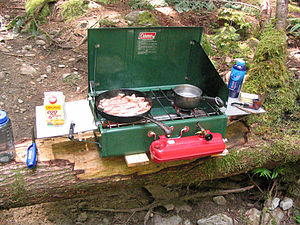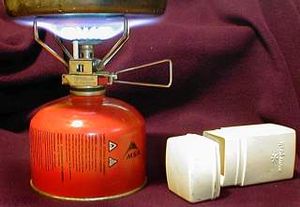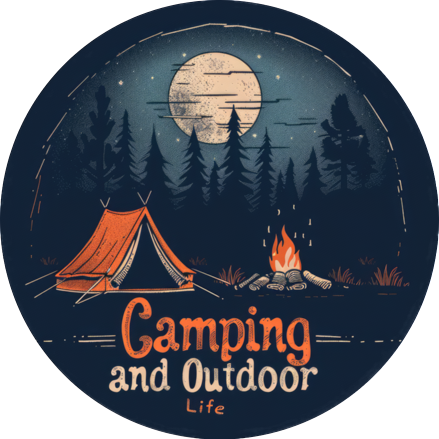
If you want the comforts of home while camping in the wilderness, you should have a camping stove as part of your camping equipment. With it, you’ll enjoy the luxury of hot meals and be able to boil water to enjoy a cup of coffee. If you still don’t have a stove as part of your camping accessories, here are the factors you should consider before you buy one.
How will you use the camping stove?
Will the stove be used at the campground while car camping? This allows you to select a larger, more full featured variety of camping stove. The Coleman camping stove pictured above is a very common stove to use while car camping.

A camping stove used for hiking will be a much smaller stove, usually with a singe burner. This stove will fold down very small for easy packing. And may add no more than a couple ounces to the pack, although the actual fuel will be heavier.
Type of Fuel
What you use to fire up your camping stove should definitely be on your mind. This is because different fuel options offer a variety of pros and cons.
- Wood – You can find wood easily in most camping locations, although it may need to be bought, don’t count on collecting firewood around a busy campground. In addition, it is a natural resource that won’t cost you much to acquire. However, stoves that use wood are heavier and don’t allow much control over the temperature. Your pots will also grow black due to the soot from the fire.
- Alcohol – For campers who travel light, alcohol powered stoves are ideally lightweight. Some campsites also provide you with this type of fuel easily. However, like wood, you can’t adjust the temperatures. Alcohol also doesn’t burn well during cold weather.
- Chemical Solids – Cakes of flammable chemicals are the lightest type of fuel for you. They won’t even take up much space. Unfortunately, they aren’t adjustable and take much time to burn. Moreover, it is quite expensive and you may spend time rubbing off the brown residue it leaves on pots.
- Liquid Petroleum – This is the standard fuel for most camping stoves. It is widely available and popularly used because it heats food quickly despite the cold temperatures and produces much heat per ounce. As for the fuel’s cons, its stoves are heavy and bulky and dangerous for inexperienced campers.
- Liquefied Gas – Liquefied gas comes in pressurized canisters which you can tag along. A camping stove using this fuel is easy to operate and will work efficiently in high altitude conditions. However, it doesn’t burn as efficiently in freezing temperatures. It is also expensive and you may have difficulty refilling the canisters. If used while hiking it’s appropriate to pack out your empty fuel canister, taking up space in the pack but should be fairly light if it’s empty.
Keep in mind access to fuel for where ever you may be planning to use the camping stove. Fuel that may be readily available in the United States may not be available elsewhere in the world. Keep in mind how altitude and temperature may effect the use of the stove.
Number of Burners
Camping stoves either come with a single burner or multiple ones. A single burner camping stove is available in heavy-duty and lightweight models. You can choose this type of burner if you cook most of your meals over the fire and if you want to travel light. Single burner stoves are also more fuel efficient since they don’t use much. On the other hand, multiple burner stoves allow you to cook more than one dish and boil water. They also come with a set of legs, which prevents them from taking up much space. Some expensive models offer additional perks like a removable coffee pot and wind guards.
Additional Considerations
The first two factors are the main ones you should consider while buying a camping stove, but there are others you can add to the list.
- Size – The size of the stove will determine whether or not you should buy it. After all, you’ll have to lug it while you hike.
- Time to Boil – All stoves operate well in moderate temperatures and when there’s no wind. However, adding both of these criteria will determine how quickly it takes to actually boil water, which is crucial since it indicates how quickly the food will be cooked.
- Rate of Simmering – Not every camping stove can keep a small flame, which means that you can burn your food more often than not. Allowing you to simmer something can also help preserve fuel. So make sure to consider this measure.
Keep these points in mind and you’re bound to get the best camping stove there is for you.







